Teacher Guide: Comprehension Strategy Resource Sets
As a teacher you know that comprehension is key to successful reading. That means teaching children to comprehend text is an essential part of any curriculum. Comprehension happens when a reader is able to think about what they have read and apply that information in a meaningful way.
So, when you think about it, teaching readers to comprehend text is really all about giving them strategies to help them think.
So, when you think about it, teaching readers to comprehend text is really all about giving them strategies to help them think.
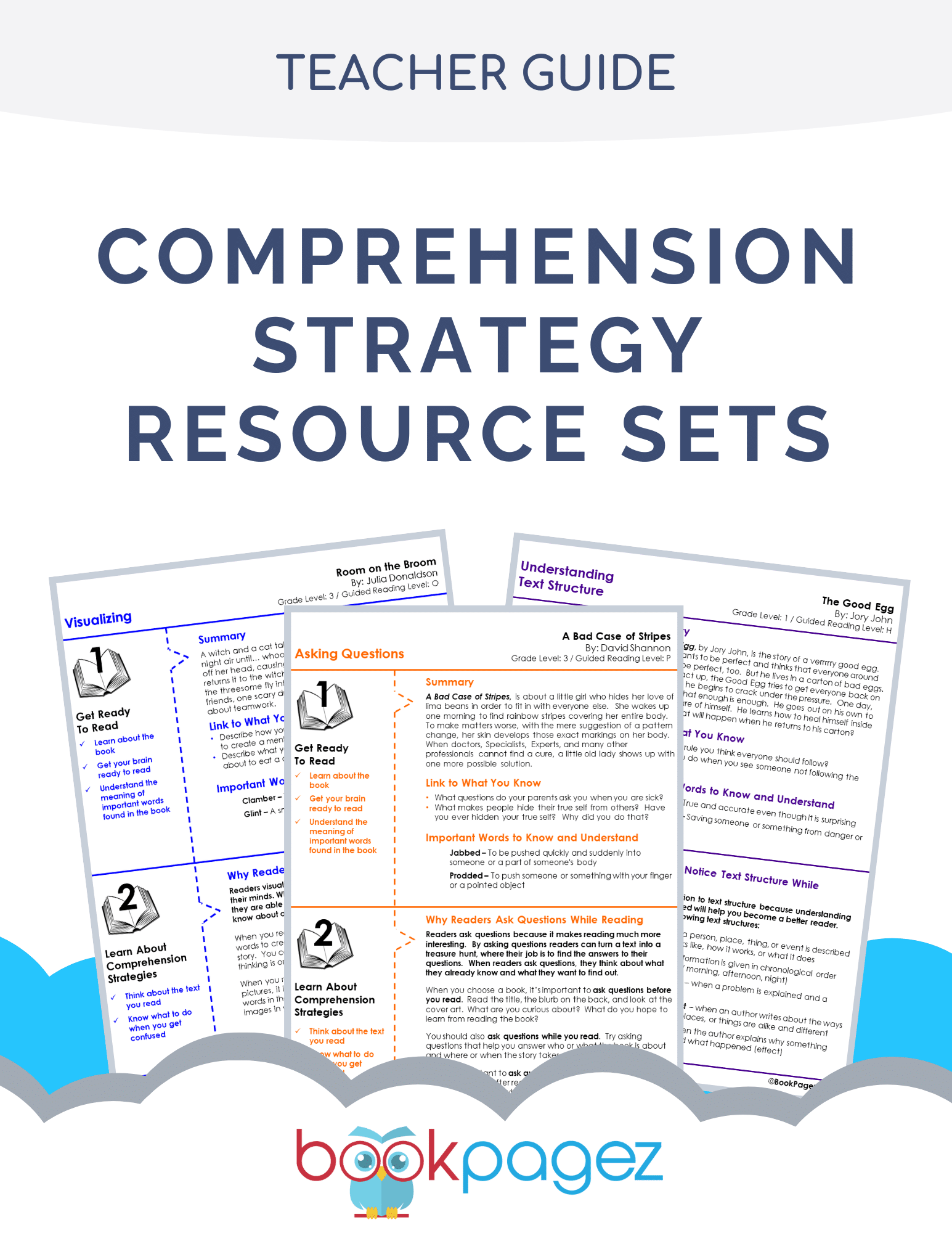
Table Of Contents
Overview of the Comprehension Strategy Resource Sets
The Comprehension Strategy Resource Sets use picture books as a springboard for instruction.
Each of the lesson plans has been specifically designed to provide readers with multiple opportunities to engage with the text and to practice using strategies to comprehend. Consequently, each lesson plan encourages readers to connect with the text, share their thinking both through writing about reading and through oral expression, and to actively engage in specific strategy practice.
The resource sets support instruction of the following (10) comprehension strategies:
Each of the lesson plans has been specifically designed to provide readers with multiple opportunities to engage with the text and to practice using strategies to comprehend. Consequently, each lesson plan encourages readers to connect with the text, share their thinking both through writing about reading and through oral expression, and to actively engage in specific strategy practice.
The resource sets support instruction of the following (10) comprehension strategies:
- Asking Questions
- Determining Importance
- Identifying the Author's Purpose
- Making Connections
- Making Inferences
- Making Predictions
- Retelling and Summarizing
- Synthesizing
- Understanding Text Structure
- Visualizing
- Four-Part Strategy Specific Lesson Plan
- Guided Practice Pages and Answer Keys
- Reader's Notebook Prompt (with optional CCSS alignment)
- Comprehension Strategy Graphic Organizer
- Common Core State Standard and TEKS Alignment
Video Walkthrough
Comprehension Strategy Lesson Plans: A Step by Step Guide
Every comprehension strategy lesson plan was designed to support a variety of instructional approaches. The resource sets are flexible enough to be used for whole-group, small-group, or one-on-one instruction.
Each lesson plan consists of 4 parts:
PART 1: Getting Ready to Read
PART 2: Learning About the Comprehension Strategies
PART 3: Using the Comprehension Strategies While Reading
PART 4: Take Time to Reflect and Write About Reading
Each lesson plan consists of 4 parts:
PART 1: Getting Ready to Read
PART 2: Learning About the Comprehension Strategies
PART 3: Using the Comprehension Strategies While Reading
PART 4: Take Time to Reflect and Write About Reading
Part 1: Getting Ready to Read
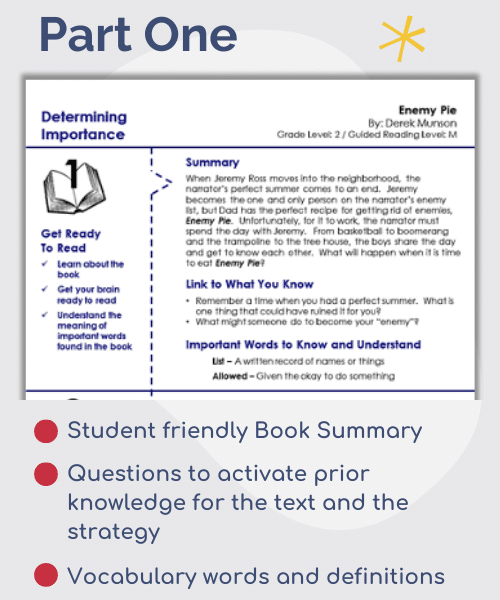
The first part of each Comprehension Strategy Lesson Plan is all about helping students connect with text. This part is super important, so don’t skip it!
As adults, we quickly move through a series of steps whenever we encounter text. For most of us it looks something like this:
As adults, we quickly move through a series of steps whenever we encounter text. For most of us it looks something like this:
- Read the title
- Read the intro – this could be the short description in a Google search, the blurb on the back of the book, or the first line of an email in your inbox
- Quickly connect with words or phrases
- Identify how the information applies to you
- Determine whether or not to read the text by setting a purpose for reading
- Begin by reading the title of the book with your students.
- Read the summary with your students. This will provide them with the key information they need (younger readers may like to take a picture walk while you read the summary to them).
- Introduce or review the “Important Words to Know and Understand” listed on the lesson plan.
- Discuss prior knowledge of the book and activate schema for the strategy using the “Link to What You Know” questions.
- Set a purpose for reading by explaining that you will be reading the book as strategy experts. This means you’ll be stopping on specific pages to practice using the strategy addressed by each lesson plan.
- As a result of moving through these steps, you’ll help students develop a thought process that will translate to all of their interactions with text.
Part 2: Learning About Comprehension Strategies
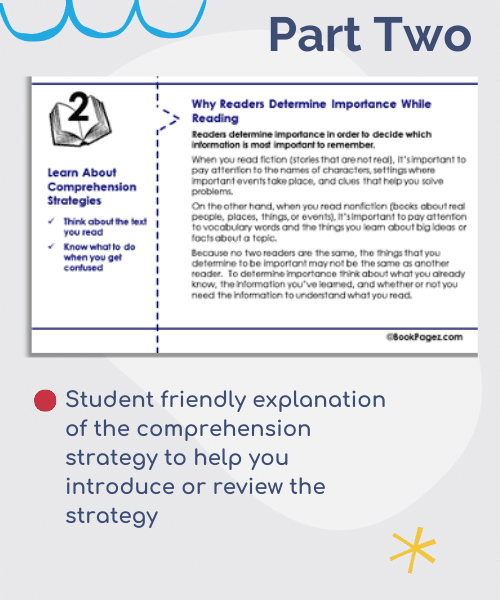
The second part of each Comprehension Strategy Lesson Plan moves the focus to a specific comprehension strategy. Depending on where you are in your instructional cycle, there are a couple of ways you might approach this part of the lesson:
1. If this is the first time students are being exposed to the strategy, take the time to fully introduce the strategy:
1. If this is the first time students are being exposed to the strategy, take the time to fully introduce the strategy:
- Read the explanation of the strategy
- Consider tracking the strategies you introduce by adding a Comprehension Strategy Poster to your classroom library
- Alternatively, you can provide students with a Comprehension Strategy Bookmark as a reference tool to use during independent reading
- Use Thinking Stems to draw connections between the new reading strategy and other comprehension strategies (i.e. This strategy reminds me of…, I could use this strategy to help me when I …)
- Read the explanation of the strategy
- Invite students to share what they know about the strategy
- Quickly review the strategy by reading the description included in the lesson plan
- Use the Comprehension Strategy Task Cards to remind students how to use the strategy while reading
Part 3: Using the Comprehension Strategies While Reading
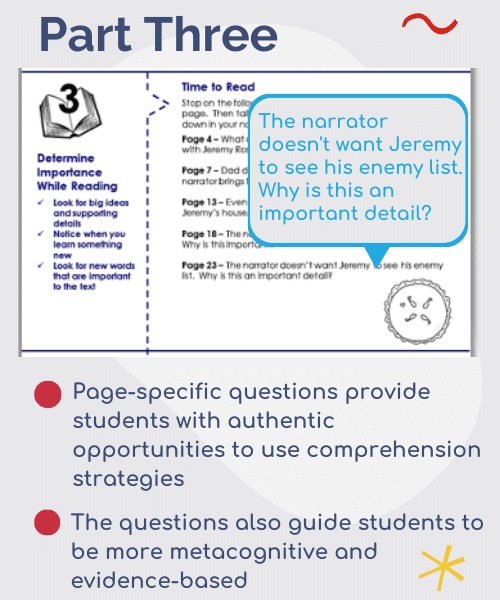
The third part of the Comprehension Strategy Lesson Plans is all about actively engaging with the text and the comprehension strategy.
When selecting texts for strategy work, it’s always helpful to choose a text that students have already read. Prior experience with the text means students will be familiar with the story, making it easier for them to focus on the strategy work to deepen their understanding.
We’ve taken the guesswork out of using picture books to teach comprehension strategies by providing you with a page by page instructional guide.
Here’s what we’ve done:
When selecting texts for strategy work, it’s always helpful to choose a text that students have already read. Prior experience with the text means students will be familiar with the story, making it easier for them to focus on the strategy work to deepen their understanding.
We’ve taken the guesswork out of using picture books to teach comprehension strategies by providing you with a page by page instructional guide.
Here’s what we’ve done:
- Identified the places in the book where students can explicitly practice each strategyProvided you with text specific guiding questions to support student use of the strategy
- Deliver a comprehension strategy minilesson. Explicitly teach readers to use the strategy by modeling your thought process to answer each of the guiding questions.
- Use the guided practice pages to teach readers how to write about their use of each strategy while reading. Model how to respond using complete sentences and how to logically express their thoughts about reading through the lens of each comprehension strategy.
- Use the practice pages during small group instruction as part of a gradual release of responsibility approach. Show students how to respond to the first guiding question, then respond to the next question together, and finally, release students to respond to the remaining questions independently or with a partner.
- Use the practice page as a tool for assessment.
Part 4: Take Time to Reflect and Write About Reading
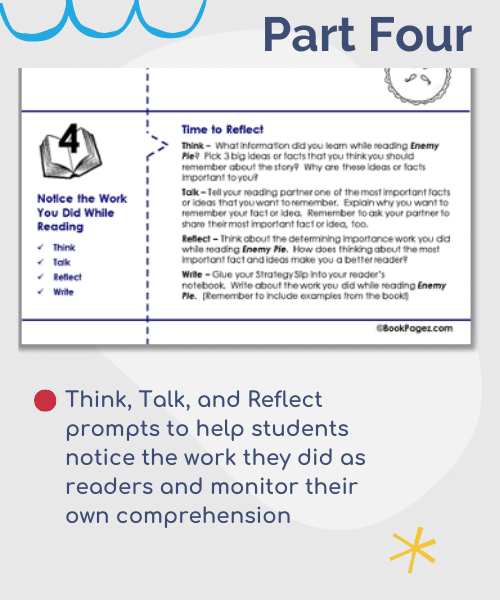
The fourth and final part of the Comprehension Strategy Lesson Plan is intended to help students develop metacognition.
Without the ability to monitor their own comprehension, students may struggle to develop as readers. Taking the time to move the strategic thought process beyond the pages of a book is important. Doing so will help students to internalize the comprehension (thinking) strategies and develop an awareness of their own level of success with text.
That’s why each lesson plan provides students with the opportunity to do the following:
Each Comprehension Strategy Lesson Plan includes a Reader’s Notebook Comprehension Strategy Slip. The Strategy Slip presents readers with a writing prompt that is directly linked to the text and the comprehension strategy. The prompt is intended to help readers respond to text in meaningful ways.
The slip has optional Common Core State Standard alignment and includes an “I Can” statement. We’ve also included an option without the Common Core alignment for teachers who do not need to align instruction to the Common Core. The final component of the Comprehension Strategy Lesson Plan is a graphic organizer.
Here are some suggestions for use:
Without the ability to monitor their own comprehension, students may struggle to develop as readers. Taking the time to move the strategic thought process beyond the pages of a book is important. Doing so will help students to internalize the comprehension (thinking) strategies and develop an awareness of their own level of success with text.
That’s why each lesson plan provides students with the opportunity to do the following:
- Think about the strategy and how they applied it to their reading
- Talk with a partner or a group about the strategy and the work they did as a reader
- Reflect on their ability to use the strategy and to ask questions if needed
- Write about the text through the lens of the comprehension strategy
Each Comprehension Strategy Lesson Plan includes a Reader’s Notebook Comprehension Strategy Slip. The Strategy Slip presents readers with a writing prompt that is directly linked to the text and the comprehension strategy. The prompt is intended to help readers respond to text in meaningful ways.
The slip has optional Common Core State Standard alignment and includes an “I Can” statement. We’ve also included an option without the Common Core alignment for teachers who do not need to align instruction to the Common Core. The final component of the Comprehension Strategy Lesson Plan is a graphic organizer.
Here are some suggestions for use:
- Use as an alternative to the practice pages during small group instruction
- Use as a resource for students who want to practice the strategy independently
- Use with books and other texts that don’t have a paired BookPagez Comprehension Strategy Lesson Plan
- If the self-evaluation forms have been collected throughout the Book Club, this is a good time to distribute and review them; noting growth and progress across the weeks
- Build your classroom reading community by discussing what students enjoyed or found challenging about participating in the literature discussion group
- Identifying sources of pride and areas to improve upon, and reflecting on takeaways from the Book Club experience that can be applied to other parts of the day
A Note About Page Numbers
The guiding questions in part 3 of the Comprehension Strategy Lesson Plans are paired with specific page numbers. Because page numbers are not consistent across all editions and publications, we have numbered the pages using the following system:
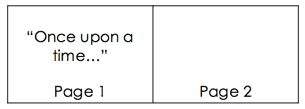
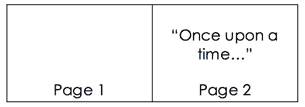
A Note About Standards Alignment

All of the Comprehension Strategy Lesson Plans include Common Core State Standard alignment. The standards listed with each lesson plan are based on the Guided Reading Level of the book pairing.
So, for example, if the book has been identified as a Guided Reading level L, the book is most appropriate for students reading at a second grade level. Therefore, we have aligned the lesson plan and included resources to the Common Core State Standards for second grade.
So, for example, if the book has been identified as a Guided Reading level L, the book is most appropriate for students reading at a second grade level. Therefore, we have aligned the lesson plan and included resources to the Common Core State Standards for second grade.


